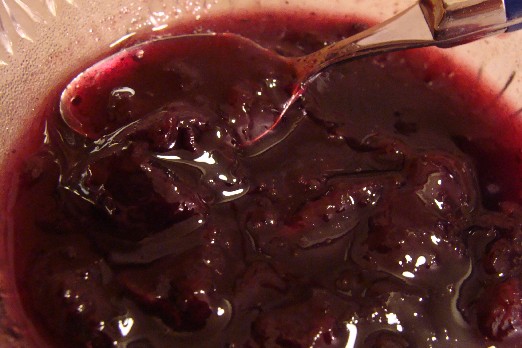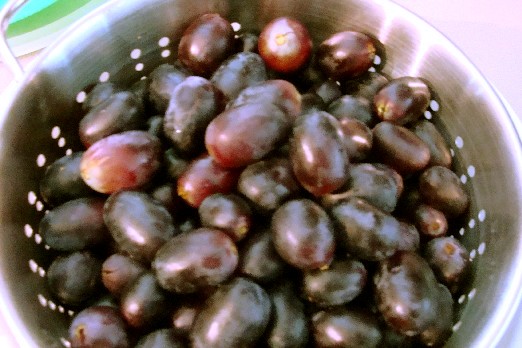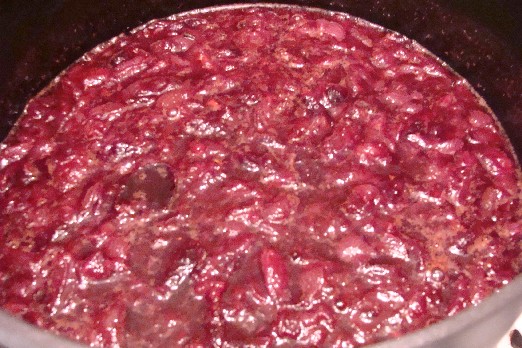Richard Barthlemess’ Spiced Grapes
From the 1922, Stag Cook Book: A Man’s Cook Book for Men
Here is the recipe # 82, offered by Richard Barthelmess.*

SPICED GRAPES
This dish is always reminiscent, to me, of low New England farmhouses, with green blinds. You know the kind – set far back from the road, among tall trees, with hollyhocks, and rose geraniums and old fashioned pinks in the garden. When I see such a house—and I can, sometimes, by closing my eyes—I can always smell the pungent scent of spiced grapes, cooking away on an immaculate kitchen range.
This is the rule for making spiced grapes. A rule that most New England families seem to follow.
To seven pounds of grapes there should be added these materials-three pounds of granulated sugar, one cup of vinegar, two tablespoonsful of ground cinnamon, and one tablespoonful of ground clovers.
Weigh the grapes, wash and pulp them. Cook the pulp until the seeds are loosened-then press the mass through a sieve. Cook the skins just as long as you cook the pulps. Put them on the same stove, but in separate kettles. Add the strained pulps to the skins, then vinegar, sugar, and spices. And cook until the mixture thickens.
This, when served with cold meat, changes a commonplace supper of left-overs into a feast.
It was tempting to take advantage of the availability of seedless grapes to avoid pulping and cooking in two separate pans. But to be true to the concept of following vintage recipes as written, I must avoid any changes that weren’t forced on me by total lack of availability. (Or the occasional outlawed ingredient.)

So, seeded grapes it was. Nice big beautiful black variety. I had to settle for California grapes this time around. But, I plan to make this recipe again in late October when the Concord grape from New England is peaking.
As with most recipes published prior to the standardization of recipe writing**, there aren’t many specifics here. The vinegar…what kind of vinegar did they use in New England in the early 1920s? I did some web investigation and it appears that, in cooking, the word vinegar almost universally applies to the apple cider variety. So that is what I used.

Then there is the imprecision of the word thickens. What is Mr. Barthelmess’ idea of thick? How long until it thickens? After 3 hours of simmering, the consistency my sauce had reached was that of a jam without enough pectin. Since it was bedtime, I covered the pot and let it sit on the stove overnight to cool.
This morning, I filled nine 8oz plastic freezer containers and had about four ounces to spare for our immediate enjoyment.

It was breakfast time. We had no cold meat left-overs as Mr. Barthelmess recommended. However, we did enjoy our Spiced Grapes on warm slices of toast with cheese.
Verdict: Viable recipe with no substitutions required. The original probably turned out to be much thicker than my results, because I suspect that on New England stoves of the early 1900s it cooked all day long instead of just three hours. Next time I will start the process early in the morning instead of at 6:30 in the evening.
* Richard Barthelmess (b. 09 May, 1895 — d. 17 Aug., 1963) was a silent film star with 75 films and 2 Oscar nominations to his credit.

** If you’re interested in finding out what goes into the construction of a written recipe, take a look at the book that always sits within easy reach on the shelf above my computer. The Recipe Writer’s Handbook by Barbara Gibbs Ostmann and Jane L. Baker.


Nine 8oz. containers? That’s a ton of grapes for an experiment.
Deborah responds:
I know, Jan. As you can imagine, 7 pounds of grapes and 3 pounds of sugar go a long way, even when they’re cooked down.